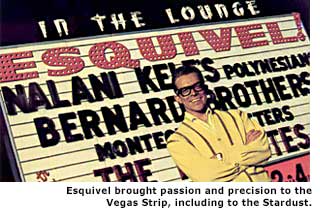Soundtrack for Modern Living: Esquivel in Orbit - Page 2
Esquivel's recordings never reached the high bar established at RCA by Harry Belafonte and Elvis Presley, but they set a standard of production that attracted the participation of top-drawer engineers and musicians. Esquivel, himself trained as an engineer in Mexico, wrote charts for both those sets of professionals. For the engineers, "there were cues, accenting the mikes in certain parts of the orchestra to pick up obscure sounds," says Reed, who kept his friend company in the studio.
Not surprisingly, Esquivel sought out modern homesteads in the Los Angeles area after he'd gotten past apartment living. His first MCM residence, according to Reed, was above Hollywood near Benedict Canyon, and he later moved to a similar home belonging to wife Joyce's sister and her husband, in Sherman Oaks.
In 1958, RCA again showcased Esquivel and their still-new technology on 'Exploring New Sounds in Stereo.' Esquivel grinned from the LP's cover with impish appeal, sporting thick-rimmed glasses (in the style of a contemporary, rock 'n' roller Buddy Holly) and leaning on a telescope.
His love of gadgetry extended into his instrumentation, which included such pioneering electric and electronic musical devices as the theremin and the ondioline. Additional unexpected and unfamiliar instruments played a part, including the harpsichord, chromatically tuned bongos, and the buzzimba (struck with mallets but sounding like a bull-froggy clarinet). The arranger's abiding love of exotic global tones was audible in his use of Brazilian, Greek, and Chinese percussion on 'Exploring New Sounds.' And slithering through this acoustic garden of earthly and astral delights was the electric guitar of Alvino Rey.

But gimmicks and glitz aside, there was ample evidence of Esquivel's thorough grounding in the elements of the big band arrangements that, over the previous three decades, had evolved in the States and then spread around the world. Esquivel was a particular fan of Stan Kenton and of Kenton arranger Pete Rugolo, and had no problem attracting L.A.'s best big band and session players to his projects, which continued with two LP volumes of 'Infinity in Sound' in 1960.
Among Esquivel's many admirers in the music business was Frank Sinatra, whose recorded repertoire to date gave proof that he knew a good arranger and an evocative arrangement when he heard one. Sinatra made his new label, Reprise, available in 1961 for the release of Esquivel's 'More of Other Worlds, Other Sounds,' which clearly echoed American big band influence.
Esquivel returned to RCA the next year, and appeared to be reaffirming his south-of-the-border identity on Latin-Esque, but that album also served to launch the record company's 'Stereo Action' series, "the first time in the history of stereo recording in which absolute separation of channels has been achieved," according to the liner notes. The achievement, under Esquivel's direction at RCA's spacious studios, involved two sets of musicians separated by the length of a city block but interconnected by headphones and closed-circuit television. Sinatra may well have been influential, soon after this experiment, in convincing Esquivel to put aside recording and set up a successful and long-lasting live show in Las Vegas.
At the Stardust on the Las Vegas strip, where his name, followed by an exclamation mark, was ensconced on the casino's space-age neon-illuminated sign, Esquivel was successful in luring gamers away from the slots and card tables and fellow performers from their own showplaces.
For the Stardust, Esquivel mined many of the arrangements from his recordings, but presented them with a much smaller instrumental ensemble, bolstered by an electronic organ. In place of the Randy Van Horne Singers were four female vocalists, one of whom, Yvonne de Bourbon, ultimately took on additional roles, as Esquivel's third wife and business manager. The visual component of 'The Sights and Sounds of Esquivel!,' as the show was dubbed, was enhanced by colored lighting and by elaborate and expensive costumes. Esquivel worked the show the way he worked everything—with passion, precision, and tight control.
When investment and control in Vegas shifted from the more flamboyant Mob to penny-pinching commercial interests, Esquivel fell out of favor. And after his divorce from Yvonne in 1978, the 68-year-old was ready to return to Mexico and a life of far less public activity. There he scored a different sort of success, composing and recording themes for a popular children's TV show called 'Burbujas' ('Bubbles'), which resulted in two good-selling albums. By this time, Esquivel's earlier LP's for RCA and Reprise had been consigned to garage sales and cheap-o bins of used record stores, where they were usually classified, ironically, as easy listening.




